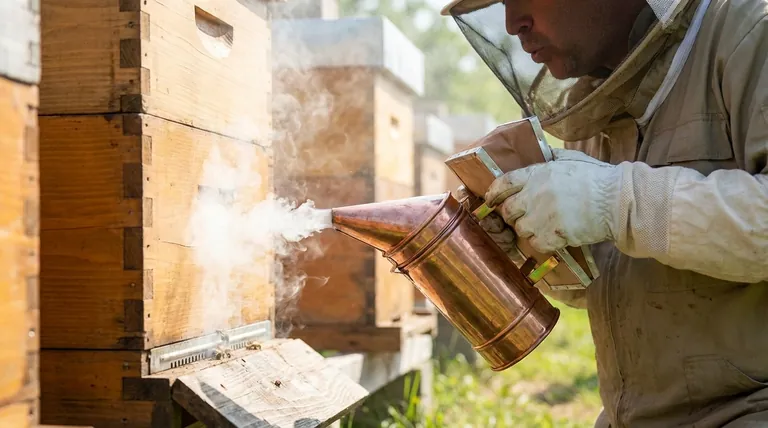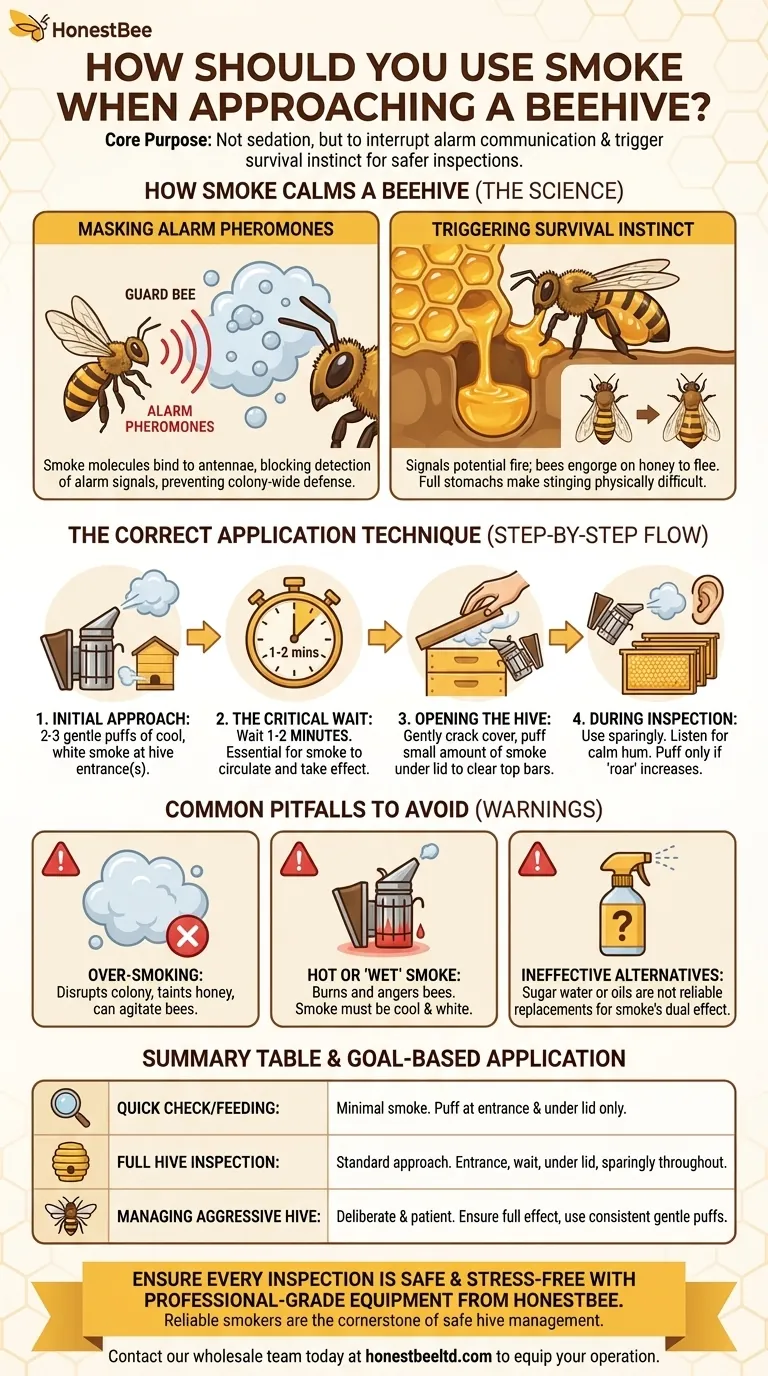To properly use smoke when approaching a beehive, you should apply a few gentle puffs of cool, white smoke near the primary entrance. If there is a second entrance, smoke that one as well. It is critical to then wait one to two minutes for the smoke to circulate and take effect before you attempt to open the hive.
The core purpose of using smoke is not to sedate the bees, but to temporarily interrupt their ability to communicate danger. By masking their alarm pheromones, you prevent a colony-wide defensive response, ensuring a safer and more productive inspection for both you and the bees.

How Smoke Actually Calms a Beehive
To use smoke effectively, it is essential to understand the biological and instinctual reactions it triggers within the colony. The effect is twofold, targeting both communication and instinct.
Masking the Alarm System
The bees' primary defense is chemical. When a guard bee perceives a threat or is crushed, it releases alarm pheromones.
This chemical signal instantly alerts other bees in the vicinity, who then orient toward the threat and become defensive. Smoke molecules effectively bind to the bees' antennae, temporarily blocking their ability to detect these specific pheromones.
By disrupting this communication channel, you prevent a single bee's alarm from escalating into a full-scale colony attack.
Triggering a Survival Instinct
Smoke also triggers a deeper, evolutionary response related to forest fires. The presence of smoke signals a potential need to abandon the hive.
In preparation for this, bees will immediately begin to engorge themselves on honey. They consume as much as possible to carry the colony's energy stores to a new location.
A bee with a full stomach of honey is physically less able to curl its abdomen into the proper stinging position. This, combined with their focus on survival, makes them significantly more docile.
The Correct Application Technique
Proper technique is about subtlety and timing. The goal is to be a calming presence, not an overwhelming force.
The Initial Approach
Start by applying two to three gentle puffs of smoke across the hive entrance from a short distance away. This pacifies the guard bees who are most likely to release the initial alarm pheromones.
After smoking the entrance, wait at least one to two minutes. This pause is non-negotiable; it allows the smoke to permeate the hive and the bees' feeding response to begin.
Opening the Hive
Once you are ready to open the hive, gently crack the outer and inner covers. Before fully removing them, puff a small amount of smoke into the opening.
This gentle application will drive the bees on the top bars down into the hive, clearing your working space and preventing them from flying up at you.
During the Inspection
Use smoke sparingly as you work. A single, gentle puff across the top of the frames is usually sufficient to keep the bees calm as you manipulate the hive.
Pay attention to the sound of the hive. A low, steady hum indicates a calm colony. If the pitch rises to a louder "roar," the bees are becoming agitated, and another small puff of smoke may be needed.
Common Pitfalls to Avoid
Improper use of smoke can be more detrimental than using no smoke at all. Understanding the common mistakes is key to effective hive management.
The Danger of Too Much Smoke
Over-smoking a hive is a frequent mistake. It can excessively disrupt the colony's work, taint the flavor of honey, and may even cause the bees to become agitated rather than calm.
Using Hot or "Wet" Smoke
The smoke you produce must be cool and white. Hot smoke, which often comes from puffing the smoker too aggressively, will burn and anger the bees, triggering a defensive response.
Similarly, if your fuel is not lit correctly, it can produce a "wet" smoke that is less effective and can be harmful to the bees.
Relying on Ineffective Alternatives
While alternatives like sugar water mist or essential oils exist, they are not nearly as reliable or effective as smoke. They do not trigger the same powerful combination of instinctual and biological responses. For any serious hive work, a properly functioning smoker is an essential piece of safety equipment.
Applying Smoke Based on Your Goal
Your approach should be tailored to the specific task you are performing.
- If your primary focus is a quick check or feeding: Use minimal smoke. A puff at the entrance and another under the lid is all that is required to prevent an initial alarm without overly disturbing the colony.
- If your primary focus is a full hive inspection: Employ the standard, methodical approach. Use smoke at the entrance, under the lid, and sparingly throughout the inspection to maintain a consistent state of calm.
- If your primary focus is managing a known aggressive hive: Be deliberate and patient. Ensure the smoke has fully taken effect before opening the hive, and be prepared to use gentle, consistent puffs to keep the colony's defensiveness in check.
Mastering the art of smoking is not about overpowering your bees; it is about learning to communicate calm in a language they instinctively understand.
Summary Table:
| Key Action | Purpose | Timing |
|---|---|---|
| Puff at Entrance | Calm guard bees, mask initial alarm pheromones. | Before opening the hive. |
| Wait 1-2 Minutes | Allow smoke to circulate and trigger feeding instinct. | After initial puffs, before opening. |
| Puff Under Lid | Clear bees from top bars, maintain calm. | As you crack the hive open. |
| Use Sparingly During Work | Manage bee temperament without over-smoking. | As needed if hive 'roar' increases. |
Ensure every hive inspection is safe and stress-free with professional-grade equipment from HONESTBEE.
Whether you manage a commercial apiary or supply beekeeping equipment to distributors, using the right tools is fundamental to success. A reliable, well-designed smoker is the cornerstone of safe hive management.
At HONESTBEE, we supply durable, high-performance beekeeping supplies and equipment through our wholesale-focused operations. Let us help you equip your operation for efficiency and safety.
Contact our wholesale team today to discuss your equipment needs and keep your colonies calm and productive.
Visual Guide

Related Products
- Premium Traditional Copper Bee Smoker with Bellows
- Stainless Steel Honey Bee Smoker Hive and Honeycomb Smoker for Beekeeping
- Stainless Steel Electric Beehive Smoker for Beekeeping and Bee Keeper Use
- European Stainless Steel Bee Smoker for Honey Bee Hive
- Economy Galvanized Beekeeping Honey Bee Smoker for Wholesale
People Also Ask
- What is the primary purpose of using smoke in beekeeping? Calm Bees for Safer Hive Management
- What is the purpose of a bee smoker and how should it be used? A Guide to Calm, Safe Hive Inspections
- What are the benefits of using smoke properly in beekeeping? Achieve Calm, Safe Hive Inspections
- What are the main parts of a bee smoker? Essential Components for Calm Hive Management
- How did early beekeepers use bee smokers? Master Ancient Bee Calming Techniques



















